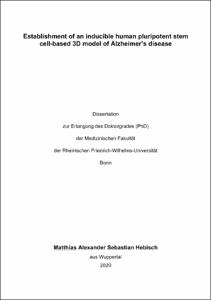Establishment of an inducible human pluripotent stem cell-based 3D model of Alzheimer's disease

Establishment of an inducible human pluripotent stem cell-based 3D model of Alzheimer's disease

| dc.contributor.advisor | Brüstle, Oliver | |
| dc.contributor.author | Hebisch, Matthias Alexander Sebastian | |
| dc.date.accessioned | 2020-11-16T14:50:57Z | |
| dc.date.available | 2021-11-16T23:00:16Z | |
| dc.date.issued | 16.11.2020 | |
| dc.identifier.uri | https://hdl.handle.net/20.500.11811/8780 | |
| dc.description.abstract | Alzheimer’s disease (AD) is the most prevalent neurodegenerative disease in the aged population. The vast majority of cases are sporadic, however, various mutations may cause early-onset, familial AD (FAD) variants. AD is characterized by deposition of amyloid β (Aβ) plaques in the extracellular space and hyperphosphorylated tau (p-tau) within neurons. This project aimed to implement a human stem cell-based model in a 3D setting in order to more authentically model extracellular Aβ accumulation and its downstream pathogenic effects. To maximize production of aggregation-prone Aβ42, the safe-harbor locus AAVS1 of human induced pluripotent stem cells (iPSCs) was modified to conditionally overexpress FAD mutations in the genes encoding the amyloid precursor protein (APPSwe/Lon) and Presenilin-1 (PS-1ΔE9). Transgenic iPSCs were differentiated into long-term self-renewing neuroepithelial stem (lt-NES) cells, and embedded in a 200-300 µm thick Geltrex matrix for long-term differentiation in 3D. Induction with doxycycline caused 40-fold increased Aβ42 secretion in 2D cultures, whereas Aβ was efficiently entrapped in the gel matrix in 3D cultures. After 8 weeks, induced 3D cultures displayed Thioflavin T-positive Aβ deposits that strongly resemble amyloid plaques in size, structure and specific autofluorescence. After 16 weeks, induced 3D cultures contained TBS-insoluble Aβ. P-tau was present in induced 3D cultures from week 6, and fibril-specific tau epitopes could be detected after 16 weeks. As expected, p-tau pathology did not develop in the presence of γ-secretase inhibitors. Cellular energy metabolism was impaired in induced cultures as p-tau-positive neurons displayed hallmarks of mitochondrial fragmentation, alongside a reduction in essential respiratory chain complexes and lowered respiratory capacity. Induced cultures also showed neuronal degeneration compared to uninduced and γ-secretase-inhibited controls. It follows that 3D matrix cultures of lt-NES neurons represent a valid model to study intra- and extracellular AD pathology in an authentic human system. | en |
| dc.language.iso | eng | |
| dc.rights | In Copyright | |
| dc.rights.uri | http://rightsstatements.org/vocab/InC/1.0/ | |
| dc.subject | Alzheimer | |
| dc.subject | 3D-Kultur | |
| dc.subject | Amyloid Phospho-tau | |
| dc.subject | lt-NES | |
| dc.subject | iPSC | |
| dc.subject | Matrix | |
| dc.subject | 3D-culture | |
| dc.subject.ddc | 570 Biowissenschaften, Biologie | |
| dc.subject.ddc | 610 Medizin, Gesundheit | |
| dc.title | Establishment of an inducible human pluripotent stem cell-based 3D model of Alzheimer's disease | |
| dc.type | Dissertation oder Habilitation | |
| dc.publisher.name | Universitäts- und Landesbibliothek Bonn | |
| dc.publisher.location | Bonn | |
| dc.rights.accessRights | openAccess | |
| dc.identifier.urn | https://nbn-resolving.org/urn:nbn:de:hbz:5-60401 | |
| ulbbn.pubtype | Erstveröffentlichung | |
| ulbbnediss.affiliation.name | Rheinische Friedrich-Wilhelms-Universität Bonn | |
| ulbbnediss.affiliation.location | Bonn | |
| ulbbnediss.thesis.level | Dissertation | |
| ulbbnediss.dissID | 6040 | |
| ulbbnediss.date.accepted | 06.11.2020 | |
| ulbbnediss.institute | Medizinische Fakultät / Institute : Institut für Rekonstruktive Neurobiologie (IRN) | |
| ulbbnediss.fakultaet | Medizinische Fakultät | |
| dc.contributor.coReferee | Wagner, Wolfgang | |
| ulbbnediss.date.embargoEndDate | 16.11.2021 |
Dateien zu dieser Ressource
Das Dokument erscheint in:
-
E-Dissertationen (1579)




